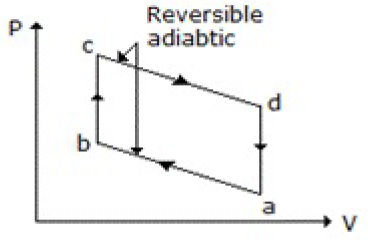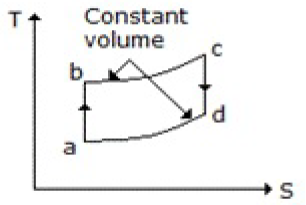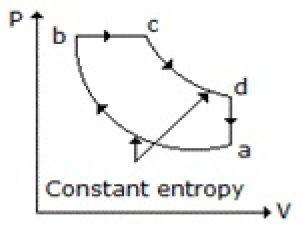Chemical Engineering Thermodynamics MCQ Solved Paper for CEED
Thursday 9th of March 2023

Sharing is caring
1. Which of the following diagrams does not represent an Otto cycle?
A.
B.
C.
D. None of these
Answer : C
A.

B.

C.

D. None of these
Answer : C
2. The compressibility factor of a gas is given by (where, V1 = actual volume of the gas V2 = gas volume predicted by ideal gas law)
A. V1/V2
B. V2/V1
C. V1 - V2
D. V1.V2
Answer : A
A. V1/V2
B. V2/V1
C. V1 - V2
D. V1.V2
Answer : A
3. For any system, what is the minimum number of degrees of freedom?
A. 0
B. 1
C. 2
D. 3
Answer : A
A. 0
B. 1
C. 2
D. 3
Answer : A
4. Sublimation temperature of dry ice (solid CO2) is __________ °C.
A. -273
B. 0
C. -78
D. 5
Answer : C
A. -273
B. 0
C. -78
D. 5
Answer : C
5. The equation relating E, P, V and T which is true for all substances under all conditions is given by (?E/?V)T = T(?P/?T)H - P. This equation is called the
A. Maxwell's equation
B. Thermodynamic equation of state
C. Equation of state
D. Redlich-Kwong equation of state
Answer : B
A. Maxwell's equation
B. Thermodynamic equation of state
C. Equation of state
D. Redlich-Kwong equation of state
Answer : B
6. In an ideal solution, the activity of a component equals its
A. Mole fraction
B. Fugacity at the same temperature and pressure
C. Partial pressure
D. None of these
Answer : A
A. Mole fraction
B. Fugacity at the same temperature and pressure
C. Partial pressure
D. None of these
Answer : A
7. The internal energy of an ideal gas does not change in a reversible __________ process.
A. Isothermal
B. Adiabatic
C. Isobaric
D. Isometric
Answer : A
A. Isothermal
B. Adiabatic
C. Isobaric
D. Isometric
Answer : A
8. Sound waves propagation in air exemplifies an __________ process.
A. Adiabatic
B. Isothermal
C. Isometric
D. None of these
Answer : A
A. Adiabatic
B. Isothermal
C. Isometric
D. None of these
Answer : A
9. For a multi-component system, the term chemical potential is equivalent to the
A. Molal concentration difference
B. Molar free energy
C. Partial molar free energy
D. Molar free energy change
Answer : C
A. Molal concentration difference
B. Molar free energy
C. Partial molar free energy
D. Molar free energy change
Answer : C
10. In a working refrigerator, the value of COP is always
A. 0
B. < 0
C. < 1
D. > 1
Answer : D
A. 0
B. < 0
C. < 1
D. > 1
Answer : D
11. dW and dq are not the exact differential, because q and W are
A. State functions
B. Path functions
C. Intensive properties
D. Extensive properties
Answer : B
A. State functions
B. Path functions
C. Intensive properties
D. Extensive properties
Answer : B
12. Mollier chart is a __________ plot.
A. Pressure vs. enthalpy
B. Pressure vs. volume
C. Enthalpy vs. entropy
D. Temperature vs. entropy
Answer : C
A. Pressure vs. enthalpy
B. Pressure vs. volume
C. Enthalpy vs. entropy
D. Temperature vs. entropy
Answer : C
13. A closed system is cooled reversibly from 100°C to 50°C. If no work is done on the system
A. its internal energy (U) decreases and its entropy (S) increases
B. U and S both decreases
C. U decreases but S is constant
D. U is constant but S decreases
Answer : B
A. its internal energy (U) decreases and its entropy (S) increases
B. U and S both decreases
C. U decreases but S is constant
D. U is constant but S decreases
Answer : B
14. For multi-component multiple phases to be in equilibrium at the same pressure and temperature, the __________ of each component must be same in all phases.
A. Chemical potential
B. Fugacity
C. Both (A) and (B)
D. Neither (A) nor (B)
Answer : C
A. Chemical potential
B. Fugacity
C. Both (A) and (B)
D. Neither (A) nor (B)
Answer : C
15. The value of Cp & Cv respectively for monatomic gases in Kcal/kg Mole.°K are
A. 5 & 3
B. 3.987 & 1.987
C. 1.987 & 0.66
D. 0.66 & 1.987
Answer : A
A. 5 & 3
B. 3.987 & 1.987
C. 1.987 & 0.66
D. 0.66 & 1.987
Answer : A
16. The temperature at which both liquid and gas phases are identical, is called the __________ point.
A. Critical
B. Triple
C. Freezing
D. Boiling
Answer : A
A. Critical
B. Triple
C. Freezing
D. Boiling
Answer : A
17. Fugacity is a measure of the
A. Escaping tendencies of the same substance in different phases of a system
B. Relative volatility of a mixture of two miscible liquids
C. Behaviour of ideal gases
D. None of these
Answer : A
A. Escaping tendencies of the same substance in different phases of a system
B. Relative volatility of a mixture of two miscible liquids
C. Behaviour of ideal gases
D. None of these
Answer : A
18. The Maxwell relation derived from the differential expression for the Helmholtz free energy (dA) is
A. (?T/?V)S = - (?P/?S)V
B. (?S/?P)T = - (?V/?T)P
C. (?V/?S)P = (?T/?P)S
D. (?S/?V)T = (?P/?T)V
Answer : D
A. (?T/?V)S = - (?P/?S)V
B. (?S/?P)T = - (?V/?T)P
C. (?V/?S)P = (?T/?P)S
D. (?S/?V)T = (?P/?T)V
Answer : D
19. Work done in an adiabatic process between two states depends on the
A. Rate of heat transmission
B. Initial state only
C. End states only
D. None of these
Answer : C
A. Rate of heat transmission
B. Initial state only
C. End states only
D. None of these
Answer : C
20. For a constant pressure reversible process, the enthalpy change (?H) of the system is
A. Cv.dT
B. Cp.dT
C. ? Cp.dT
D. ? Cv.dT
Answer : C
A. Cv.dT
B. Cp.dT
C. ? Cp.dT
D. ? Cv.dT
Answer : C
21. The variation of heat of reaction with temperature at constant pressure is given by the __________ law.
A. Kelvin's
B. Antoines
C. Kirchoffs
D./strong> None of these
Answer : C
A. Kelvin's
B. Antoines
C. Kirchoffs
D./strong> None of these
Answer : C
22. At a given temperature, the volume of a gas dissolved in a solvent __________ with increase in pressure.
A. Increases
B. Decreases
C. Remains unchanged
D. May increase or decrease; depends on the gas
Answer : C
A. Increases
B. Decreases
C. Remains unchanged
D. May increase or decrease; depends on the gas
Answer : C
23. An ideal gas is taken around the cycle ABCA as shown in P-V diagram below: The work done by the gas during the cycle is equal to

A. 12 P1V1
B. 6 P1 V1
C. 3 P1V1
D. P1 V1
Answer : C

A. 12 P1V1
B. 6 P1 V1
C. 3 P1V1
D. P1 V1
Answer : C
24. An isentropic process is carried out at constant
A. Volume
B. Pressure
C. Temperature
D. All (A), (B) and (C)
Answer : A
A. Volume
B. Pressure
C. Temperature
D. All (A), (B) and (C)
Answer : A
25. Partial molar free energy of an element A in solution is same as its
A. Chemical potential
B. Activity
C. Fugacity
D. Activity co-efficient
Answer : A
A. Chemical potential
B. Activity
C. Fugacity
D. Activity co-efficient
Answer : A
26. In a homogeneous solution, the activity coefficient of a component depends upon the
A. Pressure
B. Composition
C. Temperature
D. All (A), (B) and (C)
Answer : D
A. Pressure
B. Composition
C. Temperature
D. All (A), (B) and (C)
Answer : D
27. The enthalpy change when ammonia gas is dissolved in water is called the heat of
A. Solution
B. Formation
C. Dilution
D. Combustion
Answer : A
A. Solution
B. Formation
C. Dilution
D. Combustion
Answer : A
28. For an irreversible process involving only pressure-volume work
A. (dF)T, p <0
B. (dF)T, p = 0
C. (dF)T, p > 0
D. (dA)T, v >0
Answer : A
A. (dF)T, p <0
B. (dF)T, p = 0
C. (dF)T, p > 0
D. (dA)T, v >0
Answer : A
29. Isotherm on an enthalpy-concentration diagram, for an ideal solution will be a
A. Straight line
B. Sine curve
C. Parabola
D. Hyperbola
Answer : A
A. Straight line
B. Sine curve
C. Parabola
D. Hyperbola
Answer : A
30. Steam undergoes isentropic expansion in a turbine from 5000 kPa and 400°C (entropy = 6.65 kJ/kg K) to 150 kPa) (entropy of saturated liquid = 1.4336 kJ/kg. K, entropy of saturated vapour = 7.2234 kJ/kg. K) The exit condition of steam is
A. Superheated vapour
B. Partially condensed vapour with quality of 0.9
C. Saturated vapour
D. Partially condensed vapour with quality of 0.1
Answer : A
A. Superheated vapour
B. Partially condensed vapour with quality of 0.9
C. Saturated vapour
D. Partially condensed vapour with quality of 0.1
Answer : A
31. Which of the following processes cannot be made reversible even under ideal condition of operation?
A. Free expansion of a gas
B. Compression of air in a compressor
C. Expansion of steam in a turbine
D. All (A), (B) & (C)
Answer : A
A. Free expansion of a gas
B. Compression of air in a compressor
C. Expansion of steam in a turbine
D. All (A), (B) & (C)
Answer : A
32. Gibbs free energy at constant pressure and temperature under equilibrium conditions is
A. ?
B. 0
C. Maximum
D. Minimum
Answer : D
A. ?
B. 0
C. Maximum
D. Minimum
Answer : D
33. Charles' law for gases states that
A. V/T = Constant
B. V ? 1/T
C. V ? 1/P
D. PV/T = Constant
Answer : A
A. V/T = Constant
B. V ? 1/T
C. V ? 1/P
D. PV/T = Constant
Answer : A
34. Which of the following liquid metals has the highest thermal conductivity?
A. Molten sodium
B. Molten lead
C. Mercury
D. Molten potassium
Answer : A
A. Molten sodium
B. Molten lead
C. Mercury
D. Molten potassium
Answer : A
35. Internal energy change of a system over one complete cycle in a cyclic process is
A. Zero
B. +ve
C. -ve
D. Dependent on the path
Answer : A
A. Zero
B. +ve
C. -ve
D. Dependent on the path
Answer : A
36. Critical temperature is defined as the temperature above which a gas will
A. Not liquify (barring exceptions)
B. Immediately liquify
C. Never liquify however high the pressure may be
D. None of these
Answer : C
A. Not liquify (barring exceptions)
B. Immediately liquify
C. Never liquify however high the pressure may be
D. None of these
Answer : C
37. Entropy is a measure of the __________ of a system.
A. Disorder
B. Orderly behaviour
C. Temperature changes only
D. None of these
Answer : A
A. Disorder
B. Orderly behaviour
C. Temperature changes only
D. None of these
Answer : A
38. Pick out the correct statement.
A. Compression ratio of an Otto engine is comparatively higher than a diesel engine
B. Efficiency of an Otto engine is higher than that of a diesel engine for the same compression ratio
C. Otto engine efficiency decreases with the rise in compression ratio, due to decrease in work produced per quantity of heat
D. Diesel engine normally operates at lower compression ratio than an Otto engine for an equal output of work
Answer : B
A. Compression ratio of an Otto engine is comparatively higher than a diesel engine
B. Efficiency of an Otto engine is higher than that of a diesel engine for the same compression ratio
C. Otto engine efficiency decreases with the rise in compression ratio, due to decrease in work produced per quantity of heat
D. Diesel engine normally operates at lower compression ratio than an Otto engine for an equal output of work
Answer : B
39. Efficiency of a Carnot engine working between temperatures T1 and T2 (T1 < T) is
A. (T2 - T1)/T2
B. (T2 - T1)/T1
C. (T1 - T2)/T2
D. (T1 - T2)/T1
Answer : A
A. (T2 - T1)/T2
B. (T2 - T1)/T1
C. (T1 - T2)/T2
D. (T1 - T2)/T1
Answer : A
40. All gases during throttling process at atmospheric temperature and pressure show a cooling effect except
A. CO2
B. H2
C. O2
D. N2
Answer : B
A. CO2
B. H2
C. O2
D. N2
Answer : B
41. Fugacity co-efficient of a substance is the ratio of its fugacity to
A. Mole fraction
B. Activity
C. Pressure
D. Activity co-efficient
Answer : C
A. Mole fraction
B. Activity
C. Pressure
D. Activity co-efficient
Answer : C
42. Work done may be calculated by the expression ? p dA for __________ processes.
A. Non-flow reversible
B. Adiabatic
C. Both (A) and (B)
D. Neither (A) nor (B)
Answer : C
A. Non-flow reversible
B. Adiabatic
C. Both (A) and (B)
D. Neither (A) nor (B)
Answer : C
43. What is the value of Joule-Thomson co-efficient for an ideal gas?
A. +ve
B. -ve
C. 0
D. ?
Answer : C
A. +ve
B. -ve
C. 0
D. ?
Answer : C
44. Internal energy of an element at 1 atm and 25° C is __________ kcal/kg.mole.
A. 0
B. 273
C. 25
D. None of these
Answer : A
A. 0
B. 273
C. 25
D. None of these
Answer : A
45. A/an __________ system is exemplified by a vessel containing a volatile liquid in contact with its vapor.
A. Isolated
B. Closed
C. Open
D. None of these
Answer : C
A. Isolated
B. Closed
C. Open
D. None of these
Answer : C
46. In the equation, PVn = constant, if the value of n = 1, then it represents a reversible __________ process.
A. Isothermal
B. Isobaric
C. Polytropic
D. Adiabatic
Answer : A
A. Isothermal
B. Isobaric
C. Polytropic
D. Adiabatic
Answer : A
47. In any spontaneous process, the __________ free energy decreases.
A. Helmholtz
B. Gibbs
C. Both a & b
D. Neither 'a' nor 'b'
Answer : C
A. Helmholtz
B. Gibbs
C. Both a & b
D. Neither 'a' nor 'b'
Answer : C
48. Which of the following equations is obtained on combining 1st and 2nd law of thermodynamics, for a system of constant mass?
A. dE = Tds - PdV
B. dQ = CvdT + PdV
C. dQ = CpdT + Vdp
D. Tds = dE - PdV
Answer : A
A. dE = Tds - PdV
B. dQ = CvdT + PdV
C. dQ = CpdT + Vdp
D. Tds = dE - PdV
Answer : A
49. Which of the following is true for Virial equation of state?
A. Virial co-efficients are universal constants
B. Virial co-efficients 'B' represents three body interactions
C. Virial co-efficients are function of temperature only
D. For some gases, Virial equations and ideal gas equations are the same
Answer : C
A. Virial co-efficients are universal constants
B. Virial co-efficients 'B' represents three body interactions
C. Virial co-efficients are function of temperature only
D. For some gases, Virial equations and ideal gas equations are the same
Answer : C
50. Entropy change of the reaction, H2O (liquid) ? H2O (gas), is termed as the enthalpy of
A. Solution
B. Vaporisation
C. Formation
D. Sublimation
Answer : B
A. Solution
B. Vaporisation
C. Formation
D. Sublimation
Answer : B
Sharing is caring
Related Post
Word Power MCQ Solved Paper for CLAT PG
1000+ Chemical Engineering Thermodynamics Multiple Choice Question Answer [Solved]
1000+ Linux OS Multiple Choice Question Answer [Solved]
IBPS Common Written Exam (PO/MT) Main 2016 Solved Paper MCQ Solved Paper for IBPS RRB
Microsoft Excel 1000+ MCQ with answer for RRB ALP
CAT - Operating System 1000+ MCQ [Solved] PDF Download